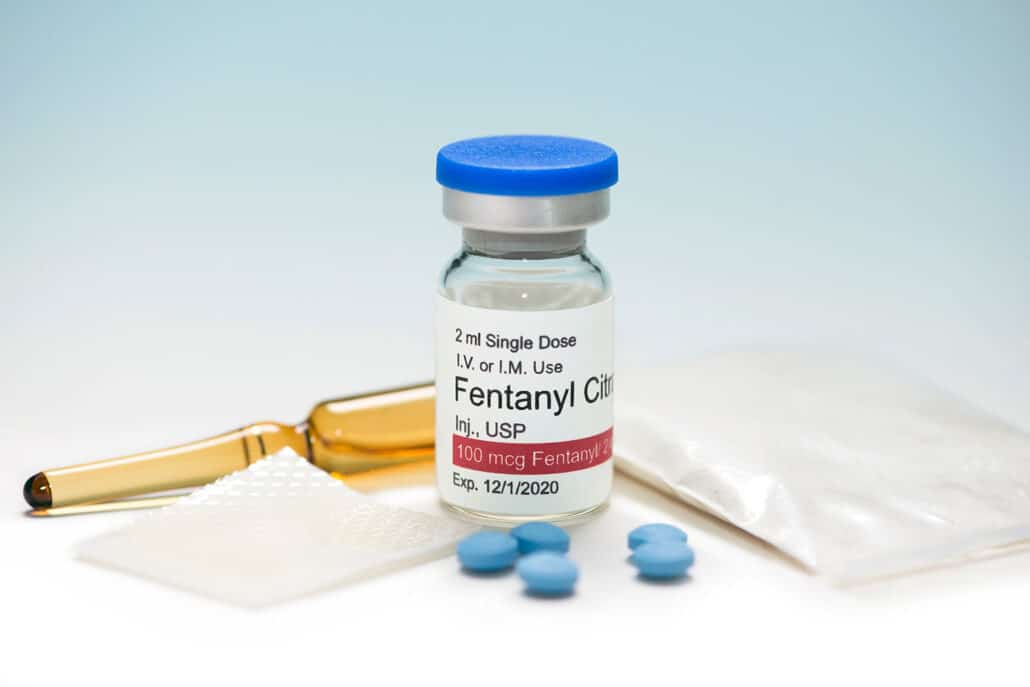Statistics indicate that the opioid crisis in the United States affects more than two million people. Thousands of overdose deaths have been attributed to opioid use disorders each year. In New York State, 4,233 overdose deaths were reported in 2020. Of these deaths, nearly 20 percent were attributable to synthetic opioids, the class of drugs that includes fentanyl. Available both as a prescription medication and as a street drug, fentanyl poses some unique risks to users.

Fentanyl is 100 times stronger than morphine and 50 times stronger than heroin, which makes it one of the most potent synthetic opioids available. A fatal overdose of fentanyl is two milligrams, the same size as about 12 grains of salt. Worse yet, fentanyl is often added to other street drugs because it is an inexpensive way to increase the high achieved by users. This can significantly increase the risk of overdose for users of these drugs.
Table of Contents
- 1 The Serious Risks of Fentanyl Use
- 2 Signs of Fentanyl Dependency
- 3 Why Medically Supervised Detox Is Essential
- 4 The Fentanyl Detox Process
- 5 Withdrawal Symptoms for Fentanyl Use Disorders
- 6 Medications Used in Fentanyl Detox
- 7 The Importance of a Safe and Supportive Detox Facility
- 8 Three Common Myths and Misperceptions About Fentanyl Detox
- 9 Continuing Recovery After Fentanyl Detox
- 10 The Long Island Interventions Approach to Fentanyl Detox and Recovery
- 11 Additional Resources
The Serious Risks of Fentanyl Use
The potency of fentanyl puts users at a much higher risk of overdose even when the medication is prescribed for them. Additionally, the rate of addiction among opioid users increases fifteen-fold among users who continue to use these substances for three months or more. In 2020, for instance, 42,700 drug overdose deaths were related to the use of fentanyl.
Unfortunately, fentanyl is relatively easy to obtain both legally and on the street. The effects of fentanyl use can include drowsiness, urinary tract disorders, nausea, vomiting and changes in the pupils of the eyes. Fentanyl is sometimes prescribed for severe pain. Because of its high degree of potency and potential for addiction, however, fentanyl is highly regulated as a prescription drug. It can cause respiratory distress, dizziness and death for its users.
Signs of Fentanyl Dependency
Fentanyl dependency can have profound effects on physical health and mental states. Some of the most common physical and mental signs of fentanyl dependency include the following:
- Nausea, vomiting and diarrhea
- Swelling of the hands and feet
- Slowed breathing
- Faster heart rate
- Fatigue or dizziness
- Loss of consciousness
- Lack of interest in hobbies and daily activities
- Anxiety
- Alternating euphoric and depressed moods
- Confusion and difficulty in focusing
- Inability to perform normal tasks and to meet responsibilities
In some cases, patients will engage in illegal activities to obtain more fentanyl. If you or a loved one is showing these signs of fentanyl addiction, seeking help from a medical detox center is essential for recovery.

Why Medically Supervised Detox Is Essential
Because fentanyl is so potent and addictive, it is unwise and unsafe for patients to attempt to navigate the withdrawal process without medical supervision. Medical detox facilities can prescribe medications that can ease the transition from fentanyl dependency to sobriety and can reduce the symptoms of withdrawal. Additionally, the therapy and coping skills available from these facilities can improve the chance of success in beating fentanyl addiction and can help patients to build a brighter tomorrow after recovery.
The Fentanyl Detox Process
The steps in the fentanyl detox process will vary depending on the severity of fentanyl dependence. At Long Island Interventions, we use proven techniques and consistent stages of treatment to manage fentanyl detox safely and effectively. The steps in our fentanyl detox process include the following:
- Performing evaluation and assessment: Upon arrival at our facility, our team of dedicated medical detox professionals will evaluate your physical condition and will ask questions about your goals for treatment, your use of fentanyl and your overall state of mind.
- Creating a treatment plan: The information gathered during your evaluation and assessment will be used to create a customized treatment plan that addresses your concerns and that offers you the best possible chance of recovery from fentanyl dependency.
- Managing symptoms of withdrawal: Once you have been evaluated and admitted, our medical team will provide you with medications designed to lessen the severity of withdrawal symptoms.
- Beginning the recovery process: After your fentanyl detox is complete, you will be offered therapy to help you acquire the coping skills necessary to maintain sobriety and to rebuild your life.
Withdrawal Symptoms for Fentanyl Use Disorders
Managing the physical symptoms of withdrawal from fentanyl is critical to successful recovery from dependence on this highly addictive substance. Medications are available that can reduce the severity of withdrawal symptoms and can increase the chance of success in overcoming fentanyl addiction. Some of the most commonly reported symptoms experienced during fentanyl withdrawal are listed here:
- Nausea, vomiting and diarrhea are among the most common gastrointestinal complaints during withdrawal from fentanyl.
- Chills and fever can occur as the body adjusts during withdrawal. In some cases, seizures and tremors may also occur.
- Pain in bones and muscles is often reported during fentanyl withdrawal. The process can heighten the patient’s sensitivity to pain.
- Red eyes and runny noses are common side effects experienced during withdrawal.
- Depression, anxiety and insomnia can also occur as a result of withdrawal from fentanyl and other drugs.
- Perhaps the most serious side effect of fentanyl withdrawal is severe craving for opioids caused by the sudden removal of these drugs from opioid receptors in the brain. Professional medical fentanyl detox is required to prevent these cravings from causing relapses in patients trying to beat addiction to this powerful drug.
During medical detoxification at Long Island Interventions, we offer therapy and medications that are designed specifically to assist patients in managing symptoms of withdrawal and to increase their chance of success in beating addiction to fentanyl. We offer the right environment and the best strategies for fentanyl withdrawal and recovery from addiction.

Medications Used in Fentanyl Detox
Depending on the severity of fentanyl dependency and the withdrawal symptoms exhibited by the patient, a variety of drugs may be used during the detox process. Some of the most common medication options include buprenorphine, buprenorphine-naloxone combinations, methadone and clonidine.
- Buprenorphine is a synthetic opioid that binds to the same opioid receptors in the brain as fentanyl. It is used as a substitute for fentanyl that cannot produce the same level of addiction. This can allow patients to taper off their use of opioids in a safer and more comfortable way.
- Buprenorphine-naloxone combines the anti-overdose properties of naloxone with buprenorphine to create a safer option for many patients recovering from fentanyl addiction.
- Methadone must be administered under the supervision of a medical provider to reduce the risk of secondary addiction to this opioid. Like buprenorphine, it is used to substitute for fentanyl during detox.
- Clonidine helps to reduce the painful symptoms of withdrawal by blocking certain signals within the brain. It can reduce the duration of detox for many patients.
The Importance of a Safe and Supportive Detox Facility
The right environment is a key element in building the right conditions for success in fentanyl detox and recovery. At Long Island Interventions, we are conveniently located in Westbury, New York, which allows our patients to enjoy easy access to inpatient and outpatient services from our team. We offer the right support in a carefully monitored environment to help you stay comfortable throughout the detox and recovery process.
Three Common Myths and Misperceptions About Fentanyl Detox
Some of the most serious barriers to effective fentanyl detox treatments come from societal attitudes toward the problem. Dispelling these myths is essential to ensure the brightest possible future for those struggling with fentanyl dependency.
- Fentanyl dependency is a psychological disorder. In fact, fentanyl dependency changes the brain chemistry and produces physical addiction that can be extremely difficult to overcome. Supervised medical detox is the safest way to manage physical withdrawal symptoms and to achieve recovery from fentanyl dependency.
- Going “cold turkey” is the best method for success. Attempting to stop using fentanyl without medical supervision and medication can result in serious physical side effects. Going it alone is not a safe option for patients struggling with fentanyl dependency.
- People with opioid use disorders are just addicts. Many of those who suffer from fentanyl dependence were first prescribed this drug for severe pain. The physical and mental effects of fentanyl use can affect anyone and are not the result of weakness or mental issues.

Continuing Recovery After Fentanyl Detox
For most patients, building the right skills and habits will require additional therapy in an inpatient setting or through outpatient services. It is essential to avoid situations that could trigger a relapse during the recovery process. By substituting healthy activities for those associated with addictive behaviors, most patients can build a better life after they complete detox and inpatient recovery programs.
The Long Island Interventions Approach to Fentanyl Detox and Recovery
At Long Island Interventions, we offer compassionate solutions and treatment plans for our patients. Our fentanyl detox programs are designed specifically to assist patients in overcoming addiction to this potent and dangerous drug. We are here to help you get your life back.
To learn more about our services or to touch base with us about fentanyl detox, contact our team by email or by phone. At Long Island Interventions, we are here to serve you.
Additional Resources
- National Institute of Drug Abuse (NIDA): Fentanyl Facts
- Centers for Disease Control and Prevention: Fentanyl
- NIDA: Overdose Death Rates
- New York State Opioid Annual Report 2022
- National Center for Drug Abuse Statistics: Fentanyl Abuse Statistics
- Substance Abuse and Mental Health Services Administration: Buprenorphine
Drug & alcohol detox programs are not directly offered by Long Island Interventions. However, we do recognize that this type of addiction treatment is often necessary and vital to one’s long-term recovery from substance abuse. If you or a loved one require any services that we do not offer we would be glad to refer you to one of our trusted affiliate providers.

